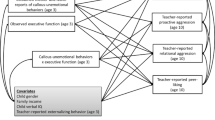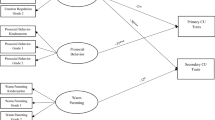Abstract
This study examined associations between childhood callous-unemotional (CU) traits and cognitive control using a conflict adaptation paradigm. Participants were (N = 158) children aged 9 to 12 years (M = 10.42, SD = 1.05; 57 % boys), who completed a modified color-word Stroop task. CU traits and conduct problems were indexed via self-reports on the Strengths and Difficulties Questionnaire and the Inventory of Callous-Unemotional Traits. CU traits were found to be uniquely associated with reduced conflict adaptation, however, this significant association was specific to boys. Conversely, conduct problems were associated with increased conflict adaptation, but among girls only. These findings contribute to evidence of atypical goal directed behavior in boys with CU traits by providing preliminary evidence that the specific impairments in cognitive control that characterize these boys include those concerning dynamic adjustments in cognitive control. Findings are discussed in relation to accounts of childhood CU traits based on the Response Modulation hypothesis.



Similar content being viewed by others
References
American Psychiatric Association (2013) Diagnostic and statistical manual of mental disorders, 5th edn. American Psychiatric Publishing, Arlington, VA
Frick PJ, Ray JV, Thornton LC, Kahn RE (2013) Can callous-unemotional traits enhance the understanding, diagnosis, and treatment of serious conduct problems in children and adolescents? A comprehensive review. Psychol Bull 140:1–57
Hawes DJ, Dadds MR (2012) Revisiting the role of empathy in childhood pathways to antisocial behavior. In: Langdon R, Mackenzie C (eds) Emotions, imagination, and moral reasoning. Psychology Press, New York, pp 45–70
Blair RJR, Budhani S, Colledge E, Scott S (2005) Deafness to fear in boys with psychopathic tendencies. J Child Psychol Psychiatry 46:327–336
Dadds MR, Perry Y, Hawes DJ, Merz S, Riddell AC, Haines DJ, Solak E, Abeygunawardane AI (2006) Attention to the eyes and fear-recognition deficits in child psychopathy. Br J Psychiatry 189:280–281
Blair RJR (2008) Fine cuts of empathy and the amygdala: dissociable deficits in psychopathy and autism. Q J Exp Psychol 61:157–170
Blair RJR, Mitchell DG (2009) Psychopathy, attention and emotion. Psychol Med 39(4):543–555. doi:10.1017/S0033291708003991
Lorenz AR, Newman JP (2002) Deficient Response Modulation and emotion processing in low-anxious Caucasian psychopathic offenders: results from a lexical decision task. Emotion 2:91–104
Newman JP, Brinkley CA, Lorenz AR, Hiatt KD, MacCoon DG (2007) Psychopathy and psychopathology: beyond the clinical utility of the psychopathy checklist—revised. In: Herve H, Yuille JC (eds) The psychopath: theory, research, and practice. Lawrence Erlbaum Associates, Mahwah, pp 173–206
Newman JP, Curtin JJ, Bertsch JD, Baskin-Sommers AR (2010) Attention moderates the fearlessness of psychopathic offenders. Biol Psychiatry 67:66–70
Hiatt KD, Schmitt WA, Newman JP (2004) Stroop tasks reveal abnormal selective attention among psychopathic offenders. Neuropsychology 18:50–59
Vitale JE, Brinkley CA, Hiatt KD, Newman JP (2007) Abnormal selective attention in psychopathic female offenders. Neuropsychology 21:301–312
Vitale JE, Newman JP, Bates JE, Goodnight J, Dodge KA, Pettit GS (2005) Deficient behavioral inhibition and anomalous selective attention in a community sample of adolescents with psychopathic traits and low-anxiety traits. J Abnorm Child Psychol 33:461–470
Botvinick MM, Braver TS, Barch DM, Carter CS, Cohen JD (2001) Conflict monitoring and cognitive control. Psychol Rev 108:624–652
Yeung N (2014) Conflict monitoring and cognitive control. In: Ochsner KN, Kosslyn S (eds) The oxford handbook of cognitive neuroscience: volume 2: the cutting edges. Oxford University Press, Oxford, pp 275–299
Larson MJ, Clawson A, Clayson PE, South M (2012) Cognitive control and conflict adaptation similarities in children and adults. Dev Neuropsychol 37:343–357
Waxer M, Morton JB (2011) The development of future-oriented control: an electrophysiological investigation. Neuroimage 56:1643–1654
Blair RJR (2013) The neurobiology of psychopathic traits in youths. Nat Rev Neurosci 14:786–799
Koenigs M (2012) The role of prefrontal cortex in psychopathy. Rev Neurosci 23:253–265
Marsh AA, Finger EC, Fowler KA, Adali CJ, Jurkowitz ITN, Schechter JC, Pine DS, Decety J, Blair RJR (2013) Empathic responsiveness in amygdala and anterior cingulate cortex in youths with psychopathic traits. J Child Psychol Psychiatry 54:900–910
Okon-Singer H, Lichtenstein-Vidne L, Cohen N (2013) Dynamic modulation of emotional processing. Biol Psychol 92:480–491
Egner T, Etkin A, Gale S, Hirsch J (2008) Dissociable neural systems resolve conflict from emotional versus nonemotional distracters. Cereb Cortex 18:1475–1484
Kerns JG (2006) Anterior cingulate and prefrontal cortex activity in an FMRI study of trial-to-trial adjustments on the Simon task. Neuroimage 33:399–405
Kerns JG, Cohen JD, MacDonald AW, Cho RY, Stenger VA, Carter CS (2004) Anterior cingulate conflict monitoring and adjustments in control. Science 303:1023–1026
Larson MJ, Kaufman DA, Perlstein WM (2009) Neural time course of conflict adaptation effects on the Stroop task. Neuropsychologia 47:663–670
Viding E, McCrory EJ (2012) Genetic and neurocognitive contributions to the development of psychopathy. Dev Psychopathol 24:969–983
Australian Bureau of Statistics (2013) Socio-Economic Indexes for Areas (SEIFA): Technical Paper 2011 (No 2033055001). Australian Bureau of Statistics, Canberra
Hawes DJ, Dadds MR, Frost AD, Hasking PA (2011) Do childhood callous-unemotional traits drive change in parenting practices? J Clin Child Adolesc Psychol 40:507–518
Goodman R (1997) The Strengths and Difficulties Questionnaire—a research note. J Child Psychol Psychiatry 38:581–586
Hawes DJ, Dadds MR (2004) Australian data and psychometric properties of the Strengths and Difficulties Questionnaire. Aust N Z J Psychiatry 38:644–651
Mellor D (2005) Normative data for the Strengths and Difficulties Questionnaire in Australia. Australian Psychologist 40:215–222
Jaffee SR, Hanscombe KB, Haworth CM, Davis OS, Plomin R (2012) Chaotic homes and children’s disruptive behavior a longitudinal cross-lagged twin study. Psychol Sci 23:643–650
Frick PJ (2004) The inventory of callous-unemotional traits. Unpublished rating scale. University of New Orleans, New Orleans
Essau CA, Sasagawa S, Frick PJ (2006) Callous-unemotional traits in a community sample of adolescents. Assessment 13:454–469
Kimonis ER, Frick PJ, Skeem JL, Marsee MA, Cruise K, Munoz LC, Morris AS (2008) Assessing callous-unemotional traits in adolescent offenders: validation of the inventory of callous-unemotional traits. Int J Law Psychiatry 31:241–252
Lawing K, Frick PJ, Cruise KR (2010) Differences in offending patterns between adolescent sex offenders high or low in callous-unemotional traits. Psychol Assess 22:298–305
Houghton S, Hunter SC, Crow J (2012) Assessing callous unemotional traits in children aged 7- to 12-years: a confirmatory factor analysis of the inventory of callous unemotional traits. J Psychopathol Behav Assess 35:215–222
Stroop JR (1935) Studies of interference in serial verbal reactions. J Exp Psychol 18:643–662
Padmala S, Bauer A, Pessoa L (2011) Negative emotion impairs conflict-driven executive control. Front Psychol 2:1–5
Gratton G, Coles MGH, Donchin E (1992) Optimising the use of information: strategic control of activation of responses. J Exp Psychol 121:480–506
Jimenez L, Mendez A (2013) It is not what you expect: dissociating conflict adaptation from expectancies in a Stroop task. J Exp Psychol Hum Percept Perform 39:271–284
Ulrich R, Miller J (1994) Effects of truncation on reaction time analysis. J Exp Psychol 123:34–80
Hart SJ, Green SR, Casp M, Belger A (2010) Emotional priming effects during Stroop task performance. Neuroimage 49:2662–2670
Aiken LS, West SG (1991) Multiple regression: testing and interpreting interactions. Sage, Newbury Park
Cohen J, Cohen P, West SG, Aiken LS (2003) Applied multiple regression/correlation analysis for the behavioral sciences, 3rd edn. Laurence Erlbaum Associates Inc, Mahwah
Dadds MR, Hawes DJ, Frost ADJ, Vassallo S, Bunn P, Hunter K, Merz S (2009) Learning to ‘talk the talk’: the relationship of psychopathic traits to deficits in empathy across childhood. J Child Psychol Psychiatry 50:599–606
Slutske WS, Heath AC, Dinwiddie SH, Madden PA, Bucholz KK, Dunne MP, Statham DJ, Martin NG (1998) Common genetic risk factors for conduct disorder and alcohol dependence. J Abnorm Psychol 107:363–374
Smith JL, Mattick RP, Sufani C (2015) Female but not male young heavy drinkers display altered performance monitoring. Psychiatry Res Neuroimaging 233:424–435
Jongen EM, Jonkman LM (2008) The developmental pattern of stimulus and response interference in a color-object Stroop task: an ERP study. BMC Neurosci 9:82
Nieuwenhuis S, Stins JF, Posthuma D, Polderman TJC, Boomsma DI, de Geus EJ (2006) Accounting for sequential trial effects in the flanker task: conflict adaptation or associative priming? Mem Cognit 34:1260–1272
Ullsperger M, Bylsma LM, Botvinick MM (2005) The conflict adaptation effect: it’s not just priming. Cognit Affect Behav Neurosci 5:467–472
Dolcos F, McCarthy G (2006) Brain systems mediating cognitive interference by emotional distraction. J Neurosci 26:2072–2079
Anticevic A, Repovs G, Barch DM (2010) Resisting emotional interference: brain regions facilitating working memory performance during negative distraction. Cognit Affect Behav Neurosci 10:159–173
Dadds MR, El Masry Y, Wilamaleera S, Guastella AJ (2008) Eye gaze explains fear recognition deficits in psychopathy. J Am Acad Child Adolesc Psychiatry 47:455–463
Newman JP, Kosson DS (1986) Passive avoidance learning in psychopathic and nonpsychopathic offenders. J Abnorm Psychol 95:252–256
Newman JP, Schmitt WA, Voss WD (1997) The impact of motivationally neutral cues on psychopathic individuals: assessing the generality of the Response Modulation hypothesis. J Abnorm Psychol 106:563–575
MacCoon DG, Wallace JF, Newman JP, Baumeister RF (2004) Self regulation: context-appropriate balanced attention. In: Vohs KS (ed) Handbook of self-regulation: research, theory, and applications. Guildford Press, New York, pp 422–444
Patterson CM, Newman JP (1993) Reflectivity and learning from aversive events: toward a psychological mechanism for the syndromes of disinhibition. Psychol Rev 100:716–736
Author information
Authors and Affiliations
Corresponding author
Rights and permissions
About this article
Cite this article
Gluckman, N.S., Hawes, D.J. & Russell, A.M.T. Are Callous-Unemotional Traits Associated with Conflict Adaptation in Childhood?. Child Psychiatry Hum Dev 47, 583–592 (2016). https://doi.org/10.1007/s10578-015-0593-4
Published:
Issue Date:
DOI: https://doi.org/10.1007/s10578-015-0593-4




